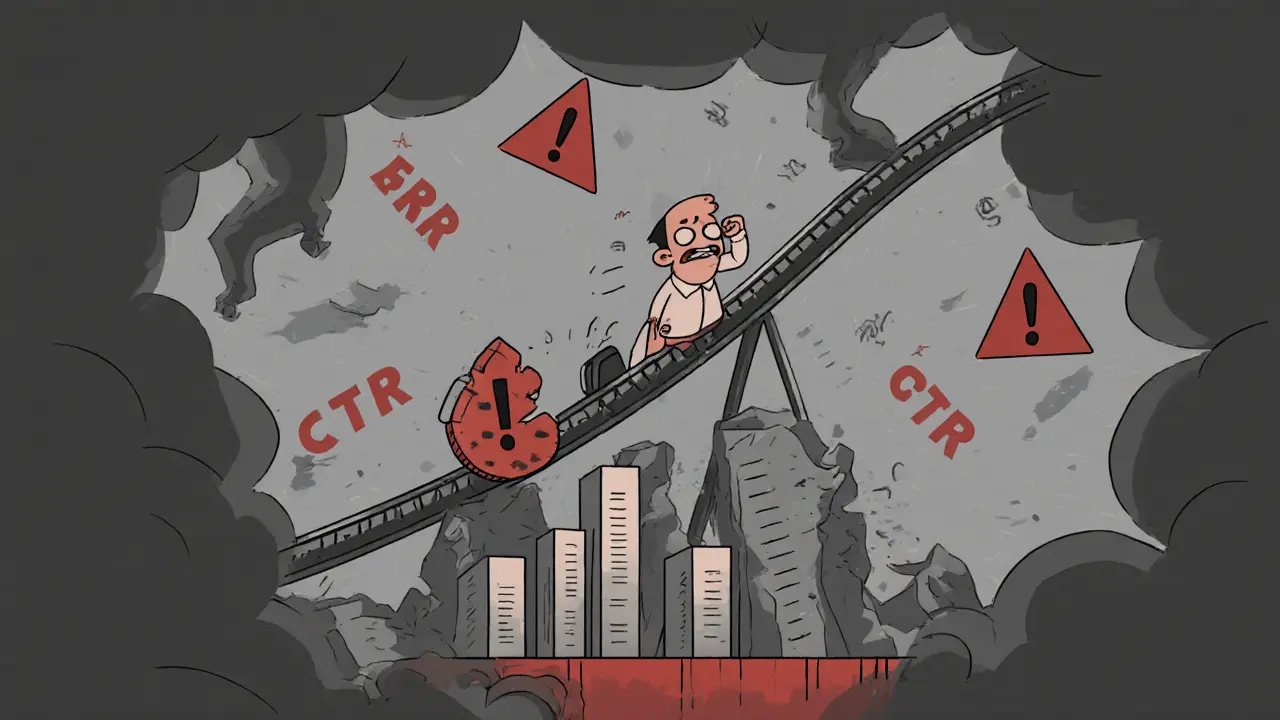CTR Token Value Calculator
Current Token Value
Current Value (Oct 2025)
1:1 Native Token Swap
Potential Value Scenarios
Important Risk Note: Current liquidity is extremely low (under $120 daily volume). These calculations assume you can trade at listed prices, which may not be possible. High risk of significant price slippage or no liquidity.
Key Takeaways
- Creator Platform (CTR) is a dual‑chain BaaS project that uses an ERC‑20 token on Ethereum and a Substrate‑based chain for scalability.
- The token’s peak price was $0.763 in September 2021; today it trades below $0.001 with a market cap under $60 K.
- Liquidity is extremely thin - only a few hundred dollars trade daily on two exchanges.
- Tokenomics include multiple fundraising rounds, a 1:1 future swap to a native CTR token, and long‑term vesting schedules for team and advisors.
- High risk: price has fallen >99%, community activity is low, and development updates are scarce.
If you're wondering what Creator Platform CTR actually does, here's the lowdown.
What is Creator Platform (CTR) Token?
Creator Platform (CTR) is a blockchain‑as‑a‑service (BaaS) platform that launched in August 2021 and issues an ERC‑20 utility token called CTR. The token powers the platform’s internal economy - users pay transaction fees, receive loyalty points, and can gift vouchers without leaving the ecosystem.
Why a Dual‑Chain Architecture?
The platform runs on two layers. On the user‑facing side it uses Ethereum to issue the ERC‑20 CTR token, which gives it instant wallet compatibility and access to existing DeFi services. Under the hood the protocol builds on Polkadot and its modular Substrate framework. This setup lets Creator Platform bridge Ethereum liquidity with Polkadot’s scalability and cross‑chain communication.
In practice, a developer can deploy a no‑code smart contract through the platform’s web UI, have the contract execute on the Substrate chain for speed, and still settle payments in ERC‑20 CTR on Ethereum. The design promises the best of both worlds - high throughput and broad market exposure.

Token Economics (Tokenomics)
CTR’s supply and distribution are outlined in the whitepaper. The total max supply is capped at 150 million tokens. As of October 2025, tracking sites differ on the circulating amount - CoinMarketCap lists 43.5 million while CoinLore reports a total of 102 million with unclear circulation.
Fundraising happened in four rounds:
- Angel Round: 10 % of tokens released at TGE, 9 % monthly vesting.
- Seed Round: sold at $0.06, 12 % TGE, 9.78 % monthly vesting.
- Private Round: $0.08 price, 15 % TGE, 10.6 % monthly vesting.
- Public Round: $0.10 price, 100 % unlocked immediately.
Team and advisors receive tokens after a 10‑month cliff, then 25 % quarterly. Marketing, rewards, foundation and ecosystem allocations vest at 1.67 % per month, spreading the release over five years.
When a native blockchain launches, the plan is to swap the ERC‑20 CTR 1:1 for a new native token, effectively moving the economy off Ethereum.
Price Performance and Market Data
CTR’s price history is a rollercoaster. The all‑time high (ATH) recorded by CoinGecko was $0.763 on 8 Sept 2021. By March 2025 the token bottomed at $0.0004197, then recovered to a narrow range around $0.0005 in October 2025.
Discrepancies are common: CoinLore’s ATH is $0.0172, and its current price shows $0.000160. These gaps stem from the token being listed on only a handful of exchanges, each with its own order books and price discovery mechanisms.
| Metric | Value |
|---|---|
| Current Price (≈) | $0.00052 |
| 24‑h Trading Volume | $117 |
| Market Cap | $56,900 |
| Circulating Supply (CMCap) | 43.5 M CTR |
| Maximum Supply | 150 M CTR |
Low volume means any sizable order can swing the price dramatically, raising slippage concerns for traders.
Risk Factors You Should Know
Investors face several red flags:
- Price Collapse - a 99.9 % drop from ATH wipes out early capital.
- Liquidity Crunch - under $120 daily volume makes exits risky.
- Data Inconsistencies - conflicting supply numbers raise transparency questions.
- Limited Exchange Access - only 2‑3 venues list CTR, concentrating order flow.
- Development Stagnation - no public roadmap updates since 2023, suggesting a possible slowdown.
While vesting schedules aim to curb massive sell‑offs, the token’s price has kept falling despite those safeguards.

How to Acquire and Store CTR
Because CTR is an ERC‑20 token, any Ethereum‑compatible wallet works: MetaMask, Trust Wallet, or hardware wallets like Ledger. To buy, you’ll have to go through the two exchanges that list it (names omitted for brevity). After purchase, transfer the tokens to your own wallet - keeping them on an exchange is especially risky given the thin order books.
When the native mainnet launches, holders will need to follow the 1:1 swap instructions posted on the official site. Until then, treat CTR as an Ethereum asset.
Future Outlook
Creator Platform’s roadmap hinges on a successful mainnet launch and a smooth token migration. If the team can demonstrate real‑world dApp usage - especially low‑code NFT tools that attract artists - the token could regain some relevance. Partnerships with larger BaaS providers or integration into Polkadot parachains would also boost credibility.
However, without fresh development updates, community growth, or clear regulatory compliance, the project may remain a niche, low‑liquidity token. Potential investors should weigh the upside of a 1:1 native swap against the downside of near‑zero liquidity and historic price decay.
Frequently Asked Questions
What is the purpose of the CTR token?
CTR powers the Creator Platform ecosystem: it pays transaction fees, rewards contributors, and serves as a voucher system for services like no‑code smart contract deployment.
Where can I buy CTR today?
Only a couple of small crypto exchanges list CTR. You’ll need to create an account, deposit a major coin (e.g., USDT), and trade for CTR. Always move the tokens to a personal wallet afterward.
Is CTR an ERC‑20 token or something else?
Currently CTR is an ERC‑20 token on Ethereum. The team plans a 1:1 swap to a native token on their Substrate chain once the mainnet goes live.
What are the biggest risks of holding CTR?
Key risks include extreme price volatility (down >99% from its peak), very low daily trading volume, inconsistent token‑supply data, limited exchange listings, and a lack of recent development updates.
How does the token swap to the native chain work?
When the mainnet launches, the project will publish a swap portal. Users connect their Ethereum wallet, approve the ERC‑20 CTR balance, and receive an equal amount of the new native CTR token on the Substrate network.

Prerna Sahrawat
September 18, 2025 AT 22:33Ah, the tragic elegy of Creator Platform’s CTR token, a symphony of grand ambition reduced to a whisper of liquidity. One cannot help but marvel at the audacity of a dual‑chain architecture that promises both Ethereum’s ubiquity and Polkadot’s scalability, yet delivers naught but a phantom market cap that flirts with obscurity. The token’s peak of $0.763, a dazzling peak that now lies buried beneath a sub‑centennial of decay, serves as a cautionary tale for those who chase glitter without substance. It is, in my estimation, a textbook case of over‑engineered hype, a pretentious venture that masquerades as innovation while neglecting the fundamentals of community engagement and developer support. The vesting schedules, meticulously crafted to ward off whales, instead appear as a bureaucratic labyrinth, diluting any hope of organic growth. Moreover, the liquidity drought-mere hundreds of dollars exchanged daily-renders any meaningful trade akin to moving a mountain with a feather. The scarcity of exchange listings compounds the problem, concentrating order flow on an infinitesimal number of venues where price manipulation becomes a trivial pursuit. In the grand tradition of cryptographic zeitgeists, the project proclaims a future native token swap, a promise that feels more like a veiled postponement than a concrete roadmap. The dissonance between the lofty whitepaper and the barren GitHub commits is palpable, and one senses a lamentable misalignment of vision and execution. As the market cap dwindles to under $60K, it becomes evident that the grandiose narrative has outpaced the actual utility of the platform. Investors, lured by the siren song of low‑code deployment, are left clutching the remnants of a dwindling ecosystem. The red flags-price collapse, thin volume, data inconsistencies-are not mere anomalies but systemic ailments that demand scrutiny. If the team were to summon the discipline to deliver tangible dApps and cultivate a vibrant community, perhaps redemption could be imagined; yet, as it stands, the token’s fate resembles a ghost ship adrift in an ocean of forgotten promises. In sum, the CTR token stands as an exemplar of crypto hubris, a cautionary monument to the perils of over‑promising and under‑delivering.
Joy Garcia
September 29, 2025 AT 17:01Honestly, reading about CTR feels like opening a secret dossier on a shadowy cabal that deliberately obscures the truth. The dual‑chain gimmick is just a smoke‑screen to distract us while the real puppeteers siphon away whatever liquidity remains. It's terrifying how they brag about a "1:1 swap" like it's some benevolent handout, when in reality it's a covert maneuver to consolidate power on a new, unregulated chain. The fact that the team hasn't posted a roadmap since 2023 screams of a coordinated cover‑up, and the wildly inconsistent supply numbers hint at deliberate data manipulation. If you think the low volume is accidental, think again-it's a classic tactic to keep prices volatile for the insiders. The whole operation reeks of elitist technocracy that cares more about appearing cutting‑edge than delivering real value. We must stay vigilant, lest this elaborate façade ensnares unsuspecting believers.
Benjamin Debrick
October 10, 2025 AT 11:28One must contemplate, with a measured yet expansive lens, the ontological implications of a token that purports to bridge disparate blockchain paradigms; indeed, the very notion of a dual‑chain synergy challenges the conventional dichotomies of scalability versus accessibility. The tokenomics, delineated with an academic rigor that borders on the pedantic, reveal a labyrinthine vesting architecture-an intricate tapestry of temporal release schedules that, while theoretically sound, may in practice engender unintended market distortions. Moreover, the stark disparity between reported circulating supplies-43.5 million versus 102 million-poses a philosophical quandary about epistemic certainty in decentralized data provenance; one is forced to ask, what is the nature of truth when contradictory metrics coexist? The liquidity profile, a mere $117 in 24‑hour volume, suggests a market micro‑structure that is, to borrow a metaphor, akin to a desert oasis-appearing inviting yet fundamentally unsustainable. Thus, the synthesis of these observations compels the discerning observer to adopt a stance of cautious skepticism, lest the allure of technological novelty obscure the underlying economic fundamentals.
Anna Kammerer
October 21, 2025 AT 05:56Wow, that's a lot of fancy talk. Sure, the math looks neat, but in reality nobody's actually using the platform. I mean, where's the real community? Without devs building stuff, all those charts mean nothing. Just another project that talks big and delivers small.
Mike GLENN
November 1, 2025 AT 00:24Reading through the whole saga, I can see why people get excited about the promise of low‑code deployment, but the numbers tell a stark story. With daily volume under $120, any attempt to move a sizable position is going to cause massive slippage, which is a nightmare for anyone trying to get in or out cleanly. If you do decide to hold, make sure you transfer the tokens off the exchange to a secure wallet; keeping them on a thin market exchange is just asking for trouble. Bottom line: treat CTR as a speculative curiosity rather than a serious investment.